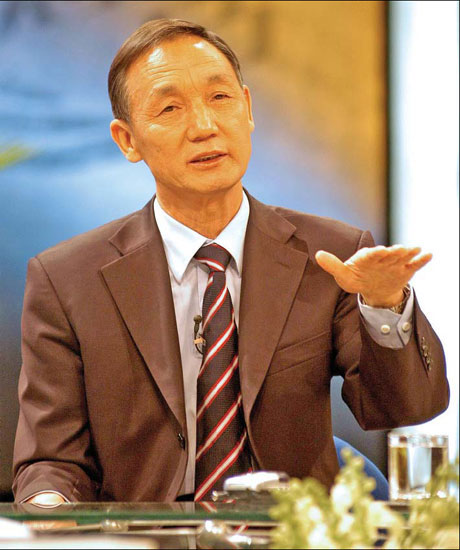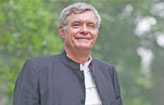From determination to domination
Updated: 2011-05-13 10:30
By Hu Haiyan (China Daily European Weekly)
 |
|
Hou Weigui, president of ZTE Corp, talks on State broadcaster CCTV's Dialogue program in this file photo. Hou started the telecommunications company at the age of 42. Provided to China Daily |
Hou weigui transforms ZTE from manufacturing business into telecommunications giant
Donning an inexpensive jacket, Hou Weigui looks more like a technician than a businessman. But the 69-year-old president of ZTE Corp helped to create the second-largest telecommunications company in China, in essence, a reflection of his own career path.
Perhaps his outward appearance comes from his days as an engineer. Until 1985, he served as a workshop director and was the director of the technology faculty at the No 691 Factory under the former Ministry of Aerospace Industry in Xi'an, Shaanxi province.
Hou loved doing laboratory work, but with higher aspirations, he organized a group of scholars and professors to start their own business. At the age of 42, when most consider looming retirement, Hou moved to Shenzhen to establish Zhongxing Semiconductor Co Ltd, the predecessor of ZTE.
Always smiling, he appears at ease. Most ZTE employees talk of his amiability. He encourages employees to get involved in business decisions, and often takes a Zen-like approach when dealing with heated situations.
When meeting Hou for the first time, his eyes are his most striking feature. Although he squints when he smiles, he seems to have his sights set on the bigger picture.
To help fund his new business, Hou manufactured a variety of items, including telephones.
He realized the growth potential of the industry in China based on what was happening in other countries and shifted the focus of ZTE from a manufacturing company to a telecommunications company, a decisive step in ZTE's development.
In the 1990s, many people in ZTE's marketing department were doubtful of the potential of the telecommunications industry and were conservative in their plans. But Hou strongly believed that the market exceeded expectations.
And the results have proved he was right.
Hou turned ZTE into China's largest publicly traded telecommunications company and the second-largest telecommunications company with 38.1 billion yuan (3.94 billion euros) in annual sales revenue last year.
At his persistence, three crucial technological developments in telecommunications helped the company achieve its status today: CDMA, a channel access method used by various radio communication technologies; PHS, which stands for Personal Handy-phone System and is also known as Little Smart or Xiaolingtong; and cell phones.
In 1995, when CDMA technology first appeared, unlike most of his competitors, ZTE focused on studying and tracking the development instead of investing in the technology. Three years later, ZTE invested in China Unicom's CDMA program. When China Unicom initiated its CDMA program in 2001, ZTE won the biggest share of the 12.1 billion yuan contracts that China Unicom issued to 10 vendors.
With the new contract, ZTE built CDMA networks in 10 provinces, supporting a total of 1.1 million users.
Another successful opportunity for ZTE was Little Smart. Though ZTE was not involved in the beginning stages of Little Smart because of doubts of its viability, the company soon surpassed its competitors in the technology. Within two years, ZTE greatly enlarged its market share of Little Smart as China's telecom carriers began to strengthen investments in Little Smart. ZTE estimates it has an about 40 percent market share of PHS equipment.
Little Smart had become the mainstay of ZTE's business. In 2005, ZTE's sales revenues hit 2.5 billion yuan, nearly half of that coming from Little Smart.
The market share for domestic mobile phones increased rapidly in 2002. At that time, ZTE initiated a push for rapid development of mobile phones.
"There are two reasons for ZTE's entry into the mobile phone market. First, there's great potential in the mobile phone market. Second, ZTE has an extensive technology base relevant to GSM, CDMA and PHS, as well as a thorough knowledge of telecommunications."
After one year, ZTE's sales of GSM, CDMA and PHS mobile phones surged to 4.5 million units and its monthly sales reached more than 1 million units by the end of 2003.
In spite of his success, ZTE employees say Hou tends to keep a low profile, rarely appearing in the company magazine.
And his modesty shines through, attributing his precise foresight to the logic of the market. But he is quite confident with ZTE's sense of judging the market's development, saying, "it is not very meaningful to ask the consultancy companies to provide long-term strategic planning for us, since it is ourselves who know the market much better."
Some describe him as a workaholic, citing his devotion to the company and long hours in the office.
In 2001, when ZTE suffered great pressure in inventory that caused a shortage in the company's capital reserves, he read many books and finally found the solutions himself. After implementing his new measures, ZTE almost realized zero inventory at that time, to reduce costs and promote organizational effectiveness.
Hou is also well-known for his thriftiness. He chooses to fly economy class and refuses to stay in luxury hotels during business trips. He advocates a careful financial policy and is quite alert to the cash flow.
But it is Hou's slow and steady pace, like a long-distance runner, that has benefited ZTE the most. He resists the temptation to quit, persevering during long-term projects.
But there is one race where he wants to be the front-runner - the international market.
"ZTE should hasten its steps to become an international telecommunications enterprise," Hou says.
He started overseas expansion in countries with underdeveloped telecommunications industries, such as Indonesia, Mexico, Ethiopia and Algeria. In 1995, ZTE took its first step toward globalization when it established branches in Indonesia. The idea was to lower the risks of overinvestment in the domestic telecommunications industry.
With a cautious strategy, ZTE has made great achievements in countries with large populations and great market potential for telecommunications. Last year, ZTE's revenue from its international operations grew 28 percent to about 38.1 billion yuan and accounted for 54 percent of its total operating revenue.
"The US and European markets are of the greatest importance for ZTE's overseas expansion, and we hope to tap these two markets in a greater scale this year," Hou says.
From the onset, Hou envisioned ZTE as a world-class enterprise. It now has 107 offices and subsidiaries in more than 100 countries and regions.
Yet the ride to the top has not always been a smooth one. ZTE has faced many challenges, not only from foreign competitors but also from longtime domestic rivals, such as Huawei.
Both are based in Shenzhen and the rivalry goes so far that their executives resent being compared to each other.
The clash has also extended into the courtroom. Huawei, China's largest telecom equipment vendor, is suing its rival ZTE over patents and trademarks in three European countries.
Huawei said it has filed lawsuits in Germany, France and Hungary, accusing ZTE of patents infringement.
ZTE has rejected Huawei's accusations and has taken legal action itself.
"ZTE Corp is astonished that Huawei Technologies has taken these legal actions," ZTE said in a statement last month. "As a company listed on the Hong Kong stock exchange, ZTE respects and adheres to international intellectual property laws and regulations without reservation, and absolutely rejects that there has been any patent and trademark infringement."
Huawei's move is the second such action directed at its smaller rival in a month and comes as ZTE is quickly expanding in Europe.
In addition to its robust expansion in both the domestic and foreign markets, ZTE has made significant advances in its internal affairs.
To strengthen the company's management, Hou pioneered the implementation of a system largely unknown in China called six sigma. Motorola and General Electric adopted the system in the 1990s that seeks to improve the final product by focusing on eliminating the defects, thus minimizing the variability in the manufacturing business.
In only two years, the six sigma management system helped to reduce operating costs at ZTE by about 200 million yuan.
ZTE has also strengthened its research and development department to ensure its long-term competitiveness.
"As a high-tech enterprise, research and development is key to our success. We will continue to invest 10 percent of our revenue into research and development each year, and will focus on the accumulation and protection of intellectual property rights in the long run to ensure our sustainable development," Hou says.
In 2004, Hou decided to slowly step back from his duties as CEO. Yin Yimin was appointed as his successor. Although ZTE has made great strides since its inception, Hou is still not satisfied.
"ZTE was established at the same time as Dell and Cisco. With the same 20 years' development, their assets are many times that of ours. If we had international management concepts and knew international trade law a little earlier, ZTE would not be just today's ZTE."
Through his 35-year career, he has worn many hats: Teacher, technician, engineer, manager and the leader of an international company. He says by sticking to his principles, he has scored the greatest achievements.
E-paper

Thawing out
After a deep freeze in sales during the recession, China’s air conditioner makers are bouncing back
Preview of the coming issue
Cool Iron lady
Of good and evil
Specials

Memory lanes
Shanghai’s historic ALLEYS not just unique architecture but a way of life

Great expectations
Hong Kong-born singer songwriter rises to the top of the UK pops.

A diplomat of character
Belgian envoy draws on personal fascination to help build China ties.
